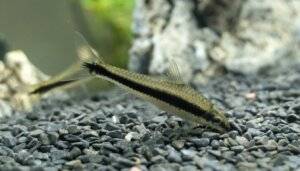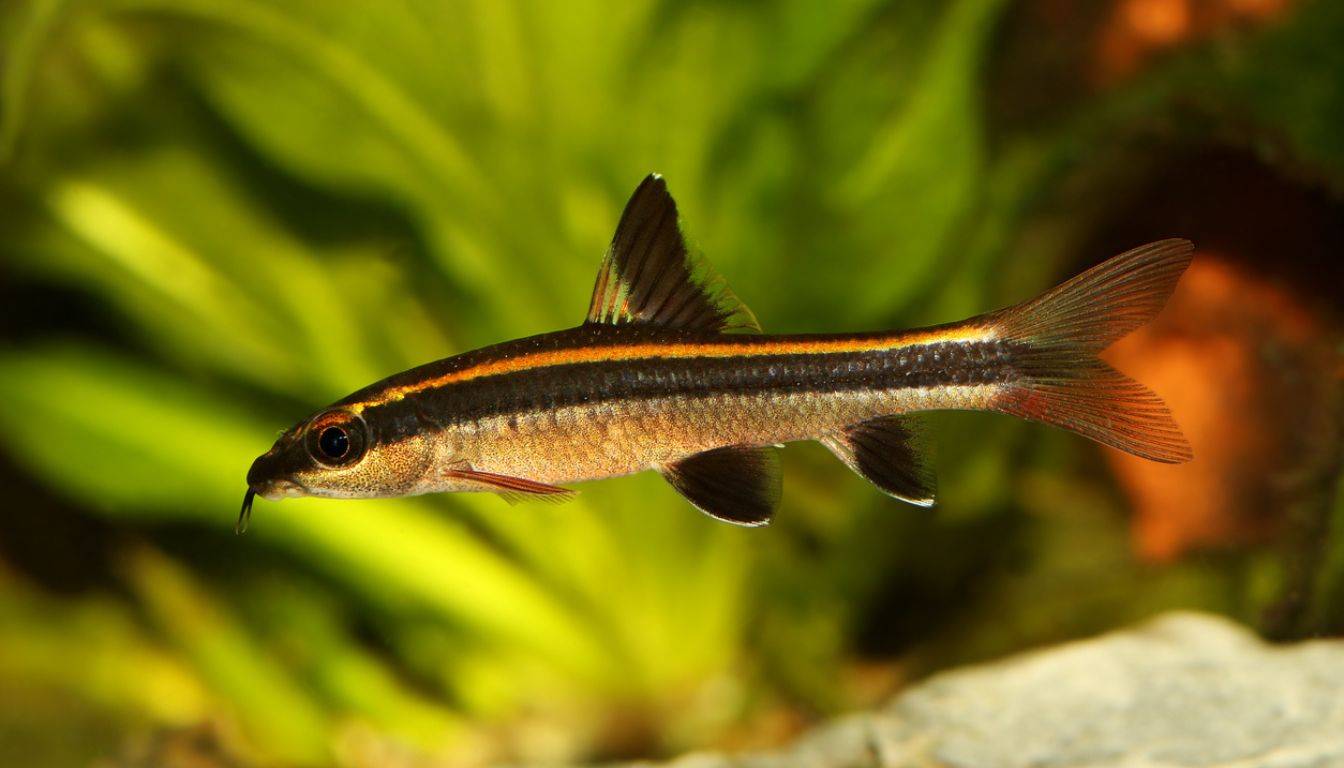Think of your home as a calming sanctuary, alive with color and peace. Imagine stepping into a room and being drawn to a beautiful underwater world. Here, agile fish with striking features move through the water effortlessly. You spot a unique fish that stands out – the Flying Fox Fish.
This fish is loved by many aquarium fans. Its bright colors and striking patterns make any tank more beautiful. It becomes the eye-catching heart of your aquarium, drawing everyone’s gaze.
What sets the Flying Fox Fish apart is its friendly behavior. It gets along well with other fish, bringing harmony to your tank. This makes it great for a tank with many different kinds of fish.
Taking care of a Flying Fox Fish is not hard, thanks to its toughness. It can live in different tank conditions, which is good news for all aquarium lovers. With the right tank setup and friends, your Flying Fox Fish will be a joyful part of your aquarium for a long time.
Habitat and Natural Behavior of Flying Fox Fish
The True Flying Fox comes from Southeast Asia. It’s found in places like the Thai Malay Peninsula, Java, Sumatra, and Borneo. They live in fast-flowing rivers and streams, which show off their beauty.
These fish like to eat off rocks or sand. They hide in things like floating houses, boats, and plants on the water’s surface. This way, they can stay safe and hidden.
Flying Fox Fish are lively and like being around others of their own kind. To keep the peace, make sure your tank has lots of places to hide and barriers. This helps them each have their own space without fights.
To make your Flying Fox Fish happy, set up their tank like their natural home. This makes them more colorful and shows off their unique patterns.
Aquarium Setup for Flying Fox Fish
Setting up the right tank for True Flying Foxes is crucial for their health and happiness. Pay attention to several important factors when preparing your aquarium:
Substrate and Decorations
Select a substrate like soft sand or smooth gravel. This choice will feel natural to True Flying Foxes and let them search for food easily. Include rocks, smooth formations, and bogwood to give them hiding spaces and make the tank look nice.
Plants for Aquascaping
Choose tough plants like Anubias and Java fern to make the tank more beautiful. These plants also create shadowy areas and hideouts for the fish. They grow well in different conditions, which makes them perfect for your fish tank.
Aquarium Size and Water Conditions
Your tank should be at least 4 feet long to suit the activity level of True Flying Foxes. Bigger tanks are even better, allowing the fish more room to move around and establish their own areas. Make sure the tank has good water flow and oxygen levels. A light that helps algae grow can be beneficial since algae are a natural food for the fish.
Creating the right space for your Flying Fox Fish not only helps them live well but also makes your aquarium look great.
Care and Feeding of Flying Fox Fish
Flying Fox Fish are quite easy to take care of, with a medium level of challenge.
They eat mostly algae, which is good for keeping your tank clean. But it’s also key to mix up their meals for all the right nutrients.
Give them high-quality dried foods like flakes or granules often. But, don’t forget to add in some small frozen or live foods like bloodworms. This mix keeps them healthy and happy.
Adding veggies like zucchini or broccoli can be very beneficial. Use blanched or steamed veggies to make it easy for your fish to eat.
Feed your flying fox fish once or twice daily, but only a little each time. Too much food can spoil the water, which is bad for them.
Recommended Diet for Flying Fox Fish
Here’s what a perfect flying fox fish diet looks like:
| Food Type | Frequency |
|---|---|
| Algae | Primary food source |
| High-quality dried foods (flakes, granules) | Regularly |
| Small frozen or live foods (bloodworms, tubifex, chopped white worms) | Regularly |
| Vegetables (zucchini, cucumber, broccoli, lettuce) | Provided as supplements |
These steps ensure your flying fox fish gets the best cae and nutrition, leading to a long and happy life in your tank.

-
Save
Tank Mates for Flying Fox Fish
Choosing the right friends for your Flying Fox Fish is crucial for a happy tank. True Flying Foxes might not get along with other Foxes or fish like the Rainbow and Red-Tailed Shark. But, they often do well with many other fish in the tank.
Good friends for a Flying Fox include larger tetras, rasboras, catfish, gouramis, and barbs. These types help create a peaceful community. They add beauty to the tank and match the Flying Fox’s style.
It’s key to pick fish that match in personality and needs with your Flying Fox. Aim for peaceful fish who like the same living conditions. Stay away from fish that are too pushy, or that need their own space. This avoids upset and fights in the tank.
Pro tip: Make sure your tank has plenty of room and hiding spots. This can reduce fights over territory. Use rocks, driftwood, and plants to give fish their own spaces. It makes for a happier tank.
Example Tank Mates for Flying Fox Fish:
- Larger tetras (such as Black Skirt Tetras or Emperor Tetras)
- Rasboras (such as Harlequin Rasboras or Scissortail Rasboras)
- Catfish (such as Corydoras or Bristlenose Plecos)
- Gouramis (such as Dwarf Gouramis or Pearl Gouramis)
- Barbs (such as Cherry Barbs or Tiger Barbs)

-
Save
Breeding and Reproduction of Flying Fox Fish
The True Flying Fox fish is fascinating yet hard to breed. It’s rare to successfully breed them at home. This is because they need special hormonal help to be farmed for the pet trade.
These fish usually breed in large rivers during the rainy season. They need certain changes in water to start mating. Mimicking this at home is tough and needs special gear and knowledge.
Challenges and Considerations
Breeding them at home faces many hurdles. It’s hard to make your tank trigger their natural spawning. Plus, the tank must offer a good spot for eggs and space for the young ones.
“Breeding True Flying Fox fish needs close water monitoring,” says Dr. Fish Expert. He’s an experienced aquarist. “Keeping the water just right is crucial for baby fish to appear.”
Remember, breeding them at home is tough and is for skilled aquarists. If you’re really into it, do your homework and talk to experts first.
The Future of True Flying Fox Fish Reproduction
Breeding True Flying Fox fish might get easier with more research and new farming methods. Understanding their breeding needs better could bring us more of these fish to enjoy.
Tank Size and Water Parameters for Flying Fox Fish
When you set up a home for your flying fox fish, tank size and water conditions are key. The right living space makes for healthy, happy fish.
Choosing the Right Tank Size
A minimum tank size of 50 gallons is best for True Flying Foxes. A larger tank is even better as it gives them more space. It lets them move freely and helps prevent stress. A big and happy fish is a healthy fish!
The Importance of Water Parameters
Good water conditions are vital for your flying fox fish. The right temperature, pH, and hardness are important.
| Water Parameter | Ideal Range |
|---|---|
| Temperature | 72-79°F (22-26°C) |
| pH Level | 6.0 to 7.5 |
| Water Hardness | 4-12 dGH |
Keep these parameters stable to mimic their natural home. Consistency is key since sudden changes can stress your fish.
Test your water often to keep it right. Using water conditioners and filters helps too. They keep the water clean and safe for your fish.
With the right tank size and water care, your flying fox fish will thrive. Remember, happy fish make for happy fishkeepers!
Conclusion
The Flying Fox Fish is a great choice for your aquarium. It brings beauty and liveliness. This fish has amazing colors, an interesting shape, and unique markings. It will catch everyone’s eye in your tank.
Flying Fox Fish can get along with other fish. They are good for community tanks.
To keep your Flying Fox Fish happy, set up their tank the right way. You need a mature tank that’s at least 4 feet long. The bottom should have soft sand or smooth gravel.
Make sure there are lots of places for your fish to hide. Adding plants like Anubias and Java fern helps, too. They create cool, shady spots for the fish to relax.
It’s important to feed your Flying Fox Fish well. They eat algae mostly. But, give them other foods, like quality dried foods and veggies. Feed them once or twice daily, and don’t overfeed. This keeps the water clean.
Follow these care tips to enjoy your Flying Fox Fish for a long time. The right home, friends in the tank, and good food will make them thrive. They’ll bring you happiness in your aquarium.
